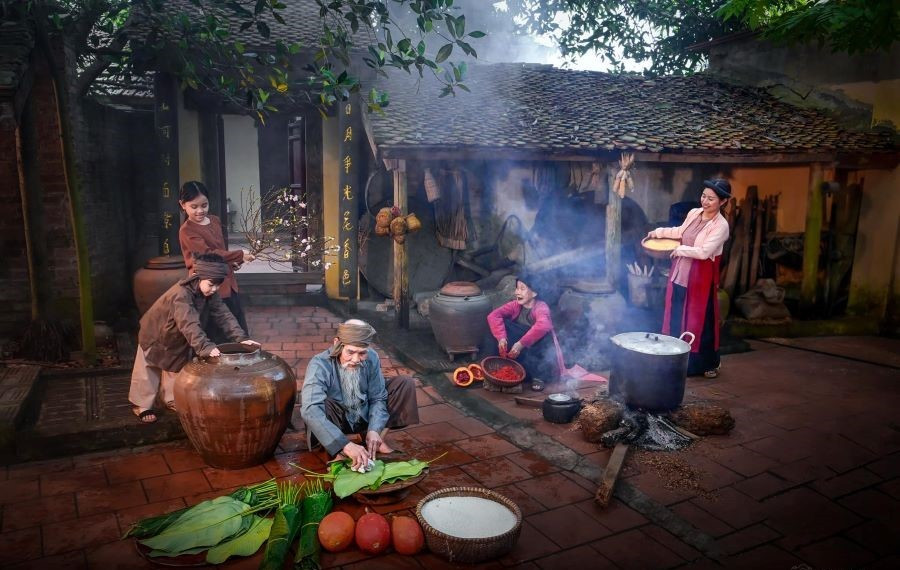
Tet, or Lunar New Year, remains the most important celebration in Vietnamese culture, despite changes over time.
The Tet is a time when people bid farewell to the old year and prepare to welcome in the new with traditional rituals and customs, hoping for the best in the coming year.
Tet market
Going to market is a chore and a joy for housewives in preparation for the feasts on the three main days of the Tet holiday. In the past, wise ladies often visited Tet market from the beginning of the 12th lunar month.
"The wife would wake up at dawn every day and go to the market to buy ingredients and store them in advance, fearing that if she waited until the full moon day of the 12th lunar month, they would be less delicious and more expensive," wrote author Vu Bang (1913-1984) in Thuong Nho Muoi Hai (Twelve Months of Nostalgia).
Nowadays, shopping for Tet is different from the old days, as services and e-commerce relieve families from stocking up, and the lady of the house also spends less time shopping around the holiday.
Nevertheless, going to the Tet can still be a pleasure that is not easy to be missed. The market embodies the local economic and cultural life, as well as the thermometer that indicates growth or crisis.
Marketplaces abound in Hanoi, the capital city once known as "Ke Cho" or the land of markets. Without counting temporary ones, author To Hoai (1920-2014) estimated that in December 1995 there were 135 markets, the most famous of which are Hom Market, Mo Market, Hang Da Market, Buoi Market, Cua Nam Market and, above all, Dong Xuan Market.
"Dong Xuan Market is the symbol of Hanoi's culinary culture, just like Dong Ba Market is for Hue's and Ben Thanh Market is for Saigon's," said historian and cultural researcher Tran Quoc Vuong (1934-2005).
Writer Vu Bang, in his book Mieng Ngon Ha Noi or Hanoian Delicacies, also mentions Hanoi's old shopping heaven: "Oh, how I miss it, how I feel it! How can I describe that soft, delicate feeling on a Sunday morning in Dong Xuan Market? It is simply 'above is the sky, below are the snack shops."
Going to Tet market is not just about buying necessities, it's also about shopping for couplets, asking for calligraphy and visiting the flower market.
Today, flower markets can be found all over Hanoi, not just in the 36 streets of the Old Quarter. Back in the day, there were designated spots for Tet flower markets. Wealthy, savvy citizens would go to Nhat Tan Ward to buy peach trees or branches, or to Quang Ba Street to buy fresh flowers. Hanoi has a famous 'Peach and Kumquat Road', covering the streets of Nghi Tam, Quang Ba, Quang An, Nhat Tan, and Phu Thuong. In the central city, flowers, peach and kumquat trees are sold in the old quarter around Dong Xuan market. Recently, Hanoians have become fond of yellow apricot blossoms from the south.
On the other hand, many people who come to Tet market do not buy much, but rather soak up the excitement and joy of Tet shopping. Seeing others happy is also a great joy for a human being.
Tet dishes
Hanoi's modern cuisine is more diverse due to cultural exchanges with the outside world. The traditional images of Tet - "fatback, pickled shallots, red couplets/New Year tree, fireworks, green sticky rice cakes" - are fading for these reasons.
Nowadays, most families order sticky rice cakes or banh chung from the shop, and the fat pork slices on Tet tray have become rarer. The sight, smell, taste and sound of the holiday are now very different from the old days.
Drinking has also changed. Ancient Hanoians drank mainly wine during the Lunar New Year - and Ke Mo wine used to be popular. In the days of the centrally planned economy, every family's Tet feast tray would include a bottle of liqueur produced by a state-owned winery and distributed with ration stamps. At present, the economy is better off and goods - including drinks - are plentiful, so people have more choices of beverages such as foreign beer and wine for the Tet holiday.
Tet Holiday celebration
While in the past Tet was almost all about eating, today it is more about drinking and relaxing. The Vietnamese have a saying: "The first day of Tet is for fathers, the second day of Tet is for mothers, the third day of Tet is for teachers", which embodies their good moral traditions. In reality, Tet has witnessed new, fascinating ways of celebrating. The elderly still maintain the custom of visiting relatives and neighbors, exchanging wishes, gifts and lucky money.
Meanwhile, the younger generation is innovating their Tet celebrations. Domestic or overseas travel during Tet is a growing trend among people with wanderlust and a passion for new experiences and cultures. Danang, Nha Trang, Quy Nhon, Mui Ne, Vung Tau, Phu Quoc or Con Dao, the sunny spots in the southern region, are Hanoians' favorite choices. Mountain lovers usually choose Dalat or other highlands in the northeast and northwest, which offer majestic natural landscapes. Many also travel to nearby Asian destinations such as Thailand, Singapore, China, Japan or South Korea during the Tet holiday.
The traditional Tet celebration has been diversified to adapt to the era of globalization and market economy.
Source: hanoimoi